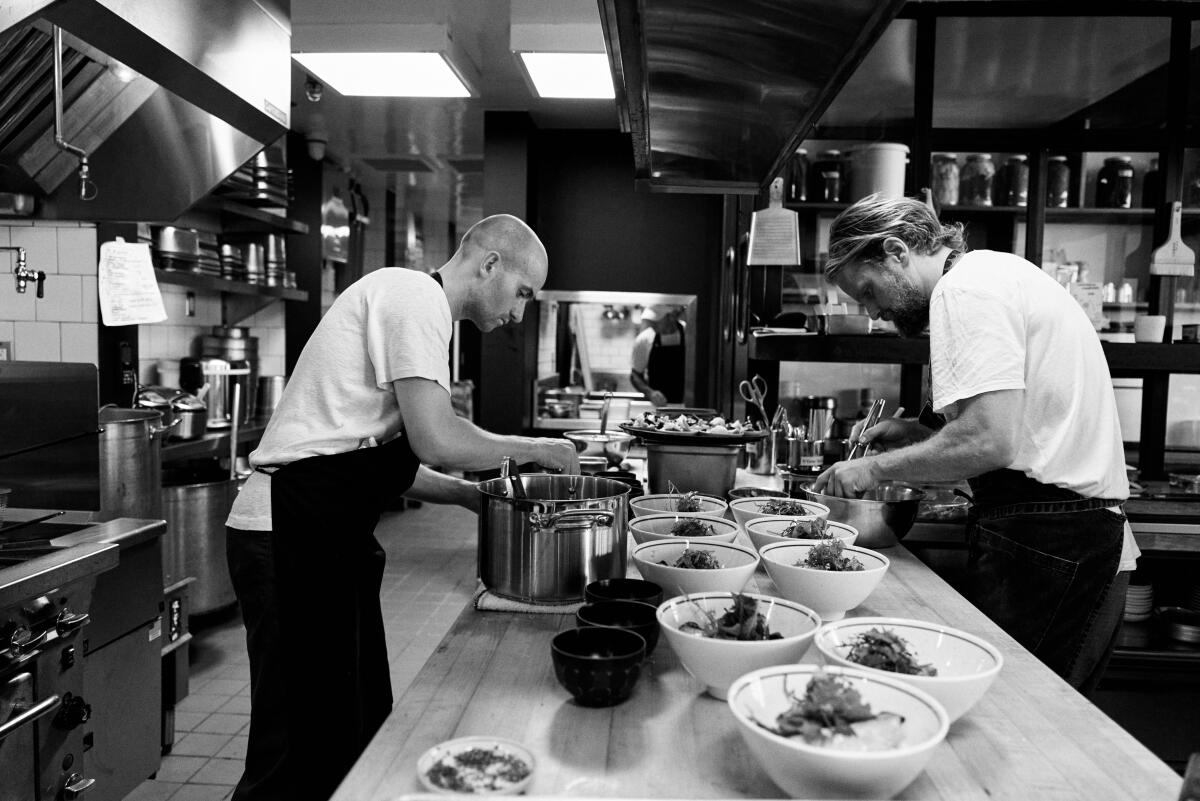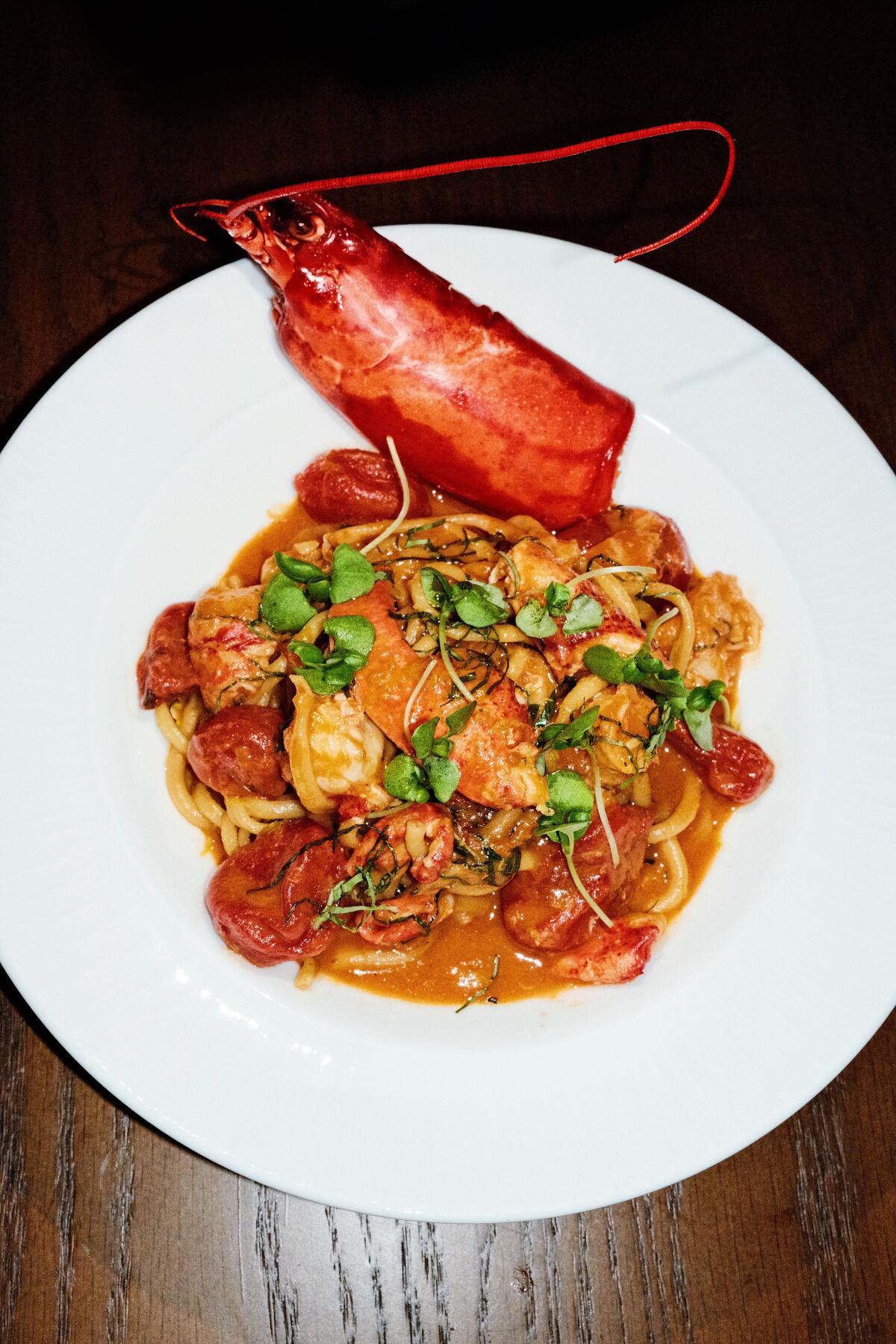Table of Contents
Travis Lett, the chef who founded some of the city’s most defining restaurants, left his Gjusta and Gjelina restaurant group in 2019. This month, he returned to the restaurant world with a new venture: RVR (pronounced “river”), a Japan-meets-California izakaya.
Lett’s trademark farmers-market focus that became hallmarks of his other Venice restaurants is now at RVR, but seen through a Japanese lens.
Greens get dunked in water and sake, grilled over binchotan and drizzled with ponzu and tonnato. Bowls of ramen feature house-made noodles utilizing freshly milled grains. Grilled squid is brushed with tomato tare and tossed with celery.
“I’ve got this long-standing love affair with Japanese food, stemming from my childhood,” he said. “My folks cooked this kind of macrobiotic vegan diet growing up, so I always had Japanese food as part of my food system at home. … I always knew I wanted to do something that combined the California market sensibility with the cooked side of Japanese food, primarily. It’s a concept that has been percolating in me for a long time.”

RVR executive chef Ian Robinson, left, with chef-owner Travis Lett in the Venice restaurant’s kitchen.
(RVR / Graydon Herriott)
He tapped executive chef Ian Robinson (formerly of Skippa in Toronto), who relocated from Kyushu. Lett reworked the space where his modern ramenya, MTN (pronounced “mountain”), ran from 2017 to 2020. At RVR, there’s more of a highlight on izakaya cuisine, with more small plates, binchotan-grilled meat and vegetable kushiyaki, and hand rolls. While there is ramen similar to the style at MTN, ramen is not the focus. The mantra this time is “simplify and refine.”
There’s also a full cocktail program, with some involving house pickle brines and pickled garnishes, and a larger focus on sake, wine and nonalcoholic beverages thanks to beverage director Maggie Glasheen (formerly of Anajak Thai and Bettina).
Lett, who trained under multiple Japanese chefs, opened MTN while still with Gjelina Group, though it occurred as the partnership’s separation was happening, which the chef called “a little distracting.” He left, and the restaurant group closed MTN in mid-2020 — but the idea of a Japanese restaurant stayed with Lett for years to come.
In the meantime he had a son, he spent more time with his family, he rode out the pandemic, he spent time surfing and traveling — focusing on himself in ways he hadn’t for years, due to operating multiple restaurants — and he waited for inspiration.

House-made ramen noodles and broth at RVR in Venice.
(RVR / Graydon Herriott)
When he found that the MTN space had, after a run as popular Oaxacan pop-up Valle, been closed and repossessed, he reached out to the bank to reclaim it.
When MTN debuted, its $20 ramen made headlines; now the price is de rigueur, but Lett said that even then he never felt the criticism was fitting. At Gjelina he sold pasta for $25 or $30 “and no one would bat an eye”; his ramen, he said, often required twice as much effort for the same price. But the understanding of Japanese food is accelerating. Only a few decades ago sushi broadly made its way to Los Angeles. But izakaya cuisine, udon specialists, kakigori slingers, local sake makers and yakitori shops have helped to broaden the public’s perception of Japanese cuisine.
Some of L.A.’s most notable new restaurants are showcasing Japanese food and culture in new ways, with Camélia blending the signatures with French bistro touches, or Rokusho’s weaving of Latin flavor. Next up is RVR.
“I think there’s been some growth and some awareness in the marketplace here, just about the diversity of Japanese food in general and also understanding that ramen doesn’t necessarily have to be just fast food,” Lett said. “There is that, but there’s levels to the game.”
RVR could also signify a new string of restaurants for the chef-owner, though he said he won’t jump into another new business or establish a hospitality group immediately.
“This style of food, this sort of moment we’re in — I feel a lot of pressure to get this right,” says Lett, “to deliver amazing product, to get the service [and] hospitality side of it right, and to find that sweet spot between quality and value. It’s taking all of my headspace.”
RVR is open from 5 to 11 p.m. Monday to Saturday and from 5 to 10 p.m. Sunday, with plans to expand with lunch service in the future.
1305 Abbot Kinney Blvd., Venice, (310) 573-8077, rvr.la

A new Long Beach restaurant from the team behind Heritage offers a la carte “neo-bistro” cuisine such as amberjack crudo with cucumber and grapes.
(Stephanie Breijo / Los Angeles Times)
Olive & Rose
A new dual-concept business from the founders of Heritage restaurant in Long Beach is now open, offering bagels during the day and “neo bistro” cuisine at night. Full Belly Food Group, the hospitality company from brother-and-sister duo Philip and Lauren Pretty, recently unveiled Olive & Rose and O&R Bagels at the base of the renovated Sonder City Center hotel.
Because the menu rotates frequently at Heritage — the Prettys’ Michelin-starred tasting menu restaurant — the chef dreamed of opening a bistro where customers can return for favorite signature dishes.

Roast chicken with foraged mushrooms, jus, frites and garlic aioli at Olive & Rose.
(Stephanie Breijo / Los Angeles Times)
“I wanted to do something that represents the last 20 years of my career on a more casual side,” said Philip Pretty, who has worked at Providence and Gordon Ramsay at the London, “but still using good products, sustainable meat and seafood, farmers-market-driven stuff, and [be] zero-waste as well.”
The result is a French-California bistro where beef tartare gets brightened by the crunch of green beans and amberjack crudo receives a garnish of cucumber and grape salad. Much like with Heritage’s fan-favorite ice cream, Olive & Rose is also spinning fresh ice cream as well as making pastry such as chocolate-and-passion-fruit tart.
While awaiting the restaurant’s full liquor license, beverage director Noah Friedman, formerly of Baby Gee, created roughly a half dozen inventive nonalcoholic concoctions that will remain part of the full cocktail program launching later this year.
O&R Bagels operates out of the Olive & Rose space but will have its own walk-up window once construction is completed.
Philip Pretty said he’d initially hoped to run his own bagel and bread program but due to limited space developed an arrangement with Costa Mesa’s Boil & Bake: A third-generation bagel maker prepares the bagels there each day before they’re transported to O+R, where they’re topped with house-cured gravlax, house-smoked salmon, salt cod brandade, caviar and more.
Olive & Rose is open from 5 to 9 p.m. Tuesday to Saturday, while O&R Bagels is open from 8 a.m. until the bagels sell out Tuesday to Saturday.
255 Atlantic Ave., Long Beach, (562) 825-8009, oliveandrose.fullbellyfoodgroup.com and fullbellyfoodgroup.com/orbagels

Chef Andrew Ponce’s A Tí pop-up serves “Los Angeles food” such as tuna tostada with salsa negra and lemon aioli and “pumpkin spice” tamales.
(Stephanie Breijo / Los Angeles Times)
A Tí Echo Park
A Tí on Sunset Boulevard is reimagining Latin flavors, made by a chef who’s spent time in some of L.A.’s top kitchens. After cooking at Bestia, Taco María and Cento, Andrew Ponce has parlayed his alleyway pop-up into a residency in the former Kushiba space.
Until at least late January, he’s serving crispy duck over date mole; fresh blue-corn tortillas; tomato-and-nopales salad with whipped feta; and tuna tostadas with salsa negra and lemon aioli; and “pumpkin spices” tamales.
“All of my food is my L.A. upbringing and a lot of foundation [is] my past restaurants, things I ate,” Ponce said. “People say ‘new-wave Mexican,’ I say ‘Los Angeles food.’ Everything’s very local.”
His masa is sourced from Boyle Heights’ Kernel of Truth Organics. His friend, Shoshi, makes the ceramics.

Crispy duck with date mole, pickles and crema, a signature of A Tí.
(Stephanie Breijo / Los Angeles Times)
His partner, Anna Kawanishi, worked at Kushiba with beverage director Dave Fernie; when the restaurant closed this fall, Fernie approached Ponce about popping up in the space and a new partnership was born. Fernie is now overseeing the beverage menu for A Tí, blending some of Kushiba’s Japanese spirits and flavors with Ponce’s Latin menu. The result? Umeboshi-tinged palomas and tomato-dashi-brightened micheladas. Kawanishi is lending a hand, too, running front-of-house operations.
Ponce also hopes to help dispel the misconception that Mexican food should be inexpensive.
While the chef offers tacos for $5, his signatures such as labor-intensive crispy duck with house-made mole or a special of rib-eye cap with burnt hoja santa crema are priced higher.
“I don’t like when people say Mexican food is cheap,” he said. “It’s not that I’m trying to make it elevated, but I want to show it in a different light.”
A Tí is open from 5 p.m. to midnight Wednesday to Sunday, with brunch service beginning in November.
1498 W. Sunset Blvd., Suite #2, Los Angeles, instagram.com/atilosangeles

West Hollywood’s Chez Mia offers upscale touches such as caviar- and gold-topped gougères.
(Stephanie Breijo / Los Angeles Times)
Chez Mia
A Provençal-inspired restaurant with a lush, sprawling patio and plenty of caviar and bubbles is breathing new life into the West Hollywood space that was once Ago.

Lobster-bisque bucatini at Chez Mia.
(Stephanie Breijo / Los Angeles Times)
Chez Mia, named for co-owner Marissa Hermer’s initials (Marissa Ilamae Anshutz), is the latest restaurant from the Boujis Group (Olivetta, the Draycott) and entrepreneur Kurt Seidensticker (Vital Proteins). The new restaurant features a bistro-leaning open kitchen indoors and a dual-sided bar, pink umbrellas, curved booths and plenty of greenery on the patio.
Executive chef Ivo Filho and consulting chef Damien Laquait built a menu of coastal- and provincial-France specialties, some traditional and others reimagined. Rustic dishes such as pissaladière tarts, warm fougasse and ratatouille are found alongside lobster-bisque bucatini, truffle-topped hamachi carpaccio, and grilled octopus in a lemon dill emulsion, while beef tartare, gougères and deviled eggs can all come topped with caviar. Truffle add-ons abound. For dessert, there are baked-to-order madeleines, tarte tropézienne, vegan pineapple carpaccio with coconut ice cream and more.
Cocktail classics like Hemingway daiquiris, the Last Word, Corpse Revivers and riffs thereof utilize juiced local produce and house-made syrups, while sommelier Erika Parjus focuses on sustainable, minimal-intervention wines from vintners along the Mediterranean Coast and in California. Chez Mia is open daily from 5 to 10 p.m.
8478 Melrose Ave., West Hollywood, (310) 933-6447, chezmia.com

Italian importer Sogno Toscano serves as both a shop for its pantry goods and specialty items, plus a restaurant for Italian sandwiches, salads and espresso.
(Stephanie Breijo / Los Angeles Times)
Sogno Toscano Beverly Grove
Italian restaurant, importer and “lifestyle cafe” Sogno Toscano touched down in California with a Santa Monica outpost last year. Today the operation from childhood friends Pietro Brembilla and Brian Persico expanded to the Grove with a 2,100-square-foot second location that features new cocktails along with its signature menu of schiacciate, or Tuscan-style sandwiches; fresh pastas; pastries; crudi; gelati; and weekend brunch items, plus a full, all-day espresso program.
In addition to its cafe menu, ample retail selection — including many house-brand items — can be purchased, including olive oils, cured meats, jarred and canned tomatoes, cheeses, wines and more. Sogno Toscano is open inside the Grove, near the shopping center’s fountain, daily from 11 a.m. to 11 p.m.
189 the Grove Drive, Suite #H2, Los Angeles, (323) 879-9443, sognotoscano.com/st-cafe-the-grove-la

